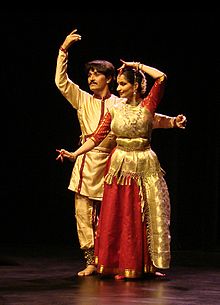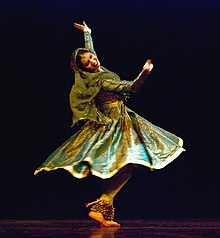Kathak
One of the Indian classical dances
Kathak (Hindi: कथक), one of the eight forms of Indian classical dances, originated from India, traces its origins to the nomadic bards of ancient northern India, known as Kathakars or storytellers. Its form today contains traces of temple and ritual dances, and the influence of the bhakti movement. From the 16th century onwards it absorbed certain features of Persian dance and central Asian dance which were imported by the royal courts of the Mughal era.






Quotes
edit- It [Kathak] is a different art form, where there is more of abhinaya.
- In Quotes. Narthaki.com. Retrieved on 17 January 2014.
- One of the eight forms of India's classical dances, Kathak, meaning “story teller,” originated in northern India, and there are references to this dance form in sources dating from the third and fourth centuries B.C. Kathak dance, today characterized by fast, rhythmic footwork, became sophisticated court entertainment with the advent of Mogul culture in northern India.
- Aydin Albayrak in Indian president's daughter enchants Ankara with Kathak dance. Today’s Zaman (9 September 2012). Retrieved on 17 January 2014.
- Natya Shastra was the root for both Bharata Natyam and Kathak, and both are of the same period. Kathak, which flourished in the North, was in the direct eye of the typhoon of invasions.
- Lavina Melwani in "Maya Rao: Grand Dame of Kathak". Hinduism Today. Retrieved on 17 January 2014.
- The dance form also underwent a mute period for 2 or 3 centuries. When it was revived by the Moghul emperors it became a secular kind of dance. But there are several actions which still have a strong Vaishnava touch.
- Maya Rao in "Maya Rao: Grand Dame of Kathak"
- First of all, classical shouldn't be called a dance. We present various expressions on abstract music, which has no meaning and no name. Interestingly, the sound and the expression depict the feeling of love or anger and hence the entire katha can be presented… it means a kind of wind is blowing and through hands, water and other five elements of earth are explained.
- Birju Maharaj in "Kathak maestro Birju Maharaj's moves leave Jains enchanted". DNA India. 19 March 2012.
- With those elegant footwork and gravity-defying turns Kathak opens a fantastical world before a dabbler, who is sure to fall deeply in love with its mesmerising ways.
- By Chencho Sherin Thomas in "Kathak has a Flexible Language". New Indian express. 4 December 2013. Retrieved on 17 January 2014.
- Kathak has three gharanas or genres named after three culturally-rich places, Lucknow, Banaras and Jaipur.
- By Chencho Sherin Thomas in "Kathak has a Flexible Language."
- Kathak has a very flexible language when compared to other classical dance forms. Due to its similarities with Spanish Flamenco dance, there are many who believe that Flamenco has been originated in India. Kathak the term was derived from ‘kathakar’ (story teller) who used to narrate vignettes from Ramayana and Mahabharatha at Hindu temples. Later on, Kathak moved to courts because of Muslim invasions. Girls from Persia(courtesans) were brought in and they performed Kathak before the Mogul kings.
- By Shila Mehta quoted in "Kathak has a Flexible Language."
- One of the most emphatic dance forms that the City of Nawabs has given - the Lucknow Gharana of Kathak, which came into existence mainly in the court of Nawab Wajid Ali Shah, the ruler of Avadh in 19th Century. Kathak, its exponents say, was so powerful that no other dance form posed a challenge to it for a long period.
- Nidhi Purohit in Kathak faces fusion challenge. Times of India (19 October 2013). Retrieved on 16 January 2014.
- Dance styles depend on the sociological background of the people who first started practising them. Take Kathak, for example. It was with the Muslim invasion that Hindustani classical music received prominence. They brought with them the tawaifs, who, along with the existing kathakas or storytellers, gave Kathak its flavour. And then, Kathak went into the darbari mode. Post that, elements of raas leela started being incorporated into Kathak, which is now, a versatile product of these influences.
- Dr Kanak Rele in "Dance has its own language: Dr. Kanak Rele". Times of India. 9 April 2011. Retrieved on 17 January 2014.
- It's sad that the art form is not appreciated in its place of origin, Lucknow, despite being popular across the globe.
- Birju Maharaj in “Kathak faces fusion challenge”
- The dance style has not changed but with less time and more work, the duration has decreased,"
- Kumkum, who choreographed the famous Sufi number Piya Haji Ali in pure Kathak style in “Kathak faces fusion challenge”
- Earlier, parents used to make their children learn this dance as a respect towards it, but now, many come to learn it to make it their profession and harbour dreams of becoming stars.
- Kamlesh Dubey in “Kathak faces fusion challenge”
- There is a new trend of foreign students coming to India, specifically to pursue full-time degree courses in Kathak and learn the nuances of this dance style.
- Kamlesh Dubey in “Kathak faces fusion challenge”
- Dance is the best yoga. Yoga is all about maintaining the concentration and finding a balance, that is exactly what we do while we dance Kathak. It's always about concentrating on 'talas' and 'w:laya:layas' and catching smallest of beats. After years that I have put behind my art, I have achieved a fine tuned balance that goes much deeper than making me able to handle my art form well.
- Birju Maharaj in "Dance is the best yoga: Birju Maharaj". Times of India. 16 January 2012. Retrieved on 17 January 2014.
- All is the play of beats and they will always remain the same as ever, you can only add instruments; so fusion is fine if created esthetically. My only concern always has been, is of maintaining the purity of our forms and not creating a fusion that confuses the audience in identifying the original beauty and qualities of our traditional dances.
- Birju Maharaj in “Dance is the best yoga: Birju Maharaj”
- Raigarh Darbar, an elite form of Kathak, encompasses the best of Kathak styles of Jaipur and Lucknow gharana. Raigarh gharana although new, has its own compositions of thumris, ghazals, todas and bols which are unique in themselves.
- In Kathak fusion leaves audience mesmerized. The Hindu (28 October 2013). Retrieved on 16 January 2014.
- In the Hindu period the dancers used to wear ghagras or saris. At the Muslim court they had to adopt the durbar dress, which was the Peshwaz worn over churidhars, seen in the Moghal paintings.
- Maya Rao in "Maya Rao: Grand Dame of Kathak"
- The costume changes have over the years been adopted by kathak dancers, mainly because the peshwaz is more comfortable and also allows viewers to see the intricate footwork which gets obstructed by saris and long ghagras. Rao uses all three costumes for her dancers-saris, ghagra-sari and the peshwaz.
- Maya Rao in "Maya Rao: Grand Dame of Kathak"
- We have several parans or rhythmic patterns based on Ganesha, which are recited or sung, along with accompaniment on the tablas. Similarly there are verses dedicated to Siva and Saraswati. There's a special invocation for Krishna, who is the patron saint of kathak dancers
- Maya Rao in "Maya Rao: Grand Dame of Kathak"
- We dance to ghazals (Urdu poems), thumris (a genre of semi-classical Indian music) and taranas (a type of Hindustani classical vocal music). There is also a spontaneity and subtle ‘abhinaya’ about Kathak. We usually dance to the syllables of tabla and pakhawaj hence there is a lot of intricate footwork,
- By Shila Mehta quoted in "Kathak has a Flexible Language."
- I was taken away by the nagma (tune), taal (rhythm) and that extempore quality of kathak. There was that openness about the art form which I could easily connect with.
- By Shila Mehta quoted in "Kathak has a Flexible Language."
- ...I take Kathak as an example, is that we are living in a very different kind of world from when Kathak first took shape and the needs of our present society are ever changing. There is a whole new generation of Indians who belong to an international and cosmopolitan community. The world is closing in on us, so to speak, and just as people from different cultures and religions are interrelating through technology, migration, hitech communication, dance also wants to be involved in this process. We are no longer living in the temples or courts; hence we must make a great leap into the international arena of dance.
- On introducing choreography into classical dance by Kumudini Lakhia in Choreography In The Indian Context. Narthaki.com (15 December 2001).
- Choreography, as understood today, requires the dance form to be put into a different kind of space. This requires a new approach of the known structures to suit new concepts. It is simply safer to keep looking over your shoulder for material from the past rather than facing the vast, open plain before you. We must come out of this safe corner and have the courage to confront this thing called creation.
- Kumudini Lakhia in "Choreography In The Indian Context".
- Solo Kathak dance did not excite me any more because it had developed too much gimmickry to it. However, I was deeply rooted in dance and the technique of Kathak itself was very artistic and complete. The way it was presented needed a lot of consideration. A performance needs to embody a certain dignity and finesse. This was my very first commitment to the presentation of Kathak. In my vision, I saw the entire stage filled with dancers, patterns of colours, music which had musicality and not just an accompanying element.
- Kumudini Lakhia in "Choreography In The Indian Context".
- Music has always been a companion to dance. One cannot think of dance without music. In classical Kathak dance, music played the role of timekeeper in the form of a "lehara" played on the sarangi. Vocal music was only used in the performance of "thumri", "bhajan", or "hori" where a dancer enacted "abhinaya" word to word. Creative music was never a part of Kathak.
- Kumudini Lakhia in "Choreography In The Indian Context".
- ...in the Kathak format, which have for long been forgotten by solo dancers. In their impulse to gain instant popularity they have concentrated only on what brings an instant response from the audiences. To this day I have not had to look outside the Kathak technique for movements and forms.
- Kumudini Lakhia in "Choreography In The Indian Context".